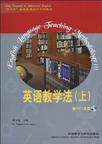英语教学法(上)
1998-11
外研社
顾曰国 编
288
无
This is Part 1 of the course English Language Teaching Methodology. The course consists of two parts, the first of which you will study in the first semester, and the secondof which you will study in the second semester. This course is divided into eleven unitsthat cover all the important aspects of language teaching, including the teaching of thefour main language skills: Reading, Listening, Speaking and Writing. The teaching ofPronunciation, Grammar, and Vocabulary, are also covered. The practical details of therole of translation in language teaching, lesson planning, classroom management andlanguage testing are also included.The aim of the course is to broaden your knowledge of the bases on which the Communicative Approach is based and to offer you a wider variety of teaching strategies andskills, which you can experiment with and adapt to the teaching situation you are working in. The course book is however only just a beginning in this learning process and thereal learning will only take place when you start to apply the knowledge you have gainedand improve your teaching.In order to help you reflect upon and apply the methodology you gain from the course,you are required to keep a diary, which will form the basis of the seminars with your tutor. At the end of each unit there is an evaluation questionnaire. You are expected toanswer those questions in your diary and be prepared to share your answers at the semi-nars. You are also expected to record in the diary anything you try out in your lessonswith an evaluation of its success or failure. By doing this right the way throughout thecourse (Parts 1 and 2), you will be well prepared to cope with the Practical Project Design, your final course of your 3-year study.
Help Yourself to a BA Course is a series specially designed for those self-study learners who want to upgrade their English from intermediate to advanced levels. It is thematically structured and five-skill intermed on activity/task basis. It consists of
顾曰国,现任中国社会科学院语言研究所研究员,当代语言学研究室主任,《当代语言学》杂志主编之一,博士生导师:获英国兰开斯特大学语言学系语言研究优等硕士学位(1985)、语用学与修辞学博士学位(1987),师从英国学术院Geoffrey Leech院士:同时兼任北京外国语大学校长助理和网络教育学院主管副院长。主要研究领域包括语用学,话语分析、语料库语言学、修辞学和英语网络教育。在国际刊物上发表论文23篇,在国内刊物上发表文章23篇,编辑学术著作4部,英语和语言学教材38部。学术兼职有国际《语用学》、《话语篇章学》、《语用学》,《语料库语言学》编审,国际语用学协会常务理事,英国诺丁汉大学特聘教授(2004-2007),英国学术院王宽城基金会院士,,香港理工大学校外学术委员和学术顾问,(2005-2008)。先后获霍英东教育基金第四届青年教师科研类一等奖,北京市哲学社会科学优秀论文一等奖,中国“国氏”博士后奖,国家级。优秀回国人员“、国家级“优秀博士后”称号等。
Warm-upActivity 1 Learning and Teaching English in China Task 1 Why Are Our Children Learning English? Task 2 How Was English Taught in the Past? Task 3 What Are Your Objectives?Activity 2 Developments in English Language Teaching Methodology Task 1 What Is Language for? Task 2 The Grammar-Translation Method Task 3 A Functional-Notional Approach Task 4 Social Aspects of Language Task 5 Parallels Between First and Second Language Learning Task 6 Expressing One's Meaning Task 7 "A Worthy Old Teacher" Task 8 The Humanist Approach Task 9 An Eclectic ApproachActivity 3 Course Design Task 1 Different Types of Syllabus Task 2 Needs Analysis Task 3 The Stages of Course Design Task 4 The Design of Senior English for ChinaActivity 4 Your Own Development as a Teacher Task 1 What Are Your Best Qualities? Task 2 How Can You Improve Your Teaching? Review Of This Unit
插图:This is how the Grammar-Translation Method came about. The grammar of the classi-cal language had to be described and broken down into learnable chunks: verbs wereconjugated, nouns were declined, tenses were explained and exemplified. The vocabu-lary also had to be listed and learned with a great deal of attention paid to the morpholo-gy of the words, how they were made up and combined. The rules of pronunciationwere described, they were regular, and they had to be learnt only so that the texts couldbe read aloud. The general method used in the classroom was as follows: the text wouldbe the basis of the lesson, its vocabulary drawn out and learnt with the mother-tonguetranslation, the grammar points drawn out and explained in the mother tongue, somepractice was done with translating sentences containing these structures and words (firsttarget language into mother tongue, then mother tongue into target language), then thetext would be read aloud sentence by sentence and each one would be translated. Thestudents would normally be tested by having to perform translations. Does this sound fa-miliar?How would the syllabus be organised? Well, usually it was designed around grammaticalstructures. Each lesson would teach a grammar structure, starting with simple ones,like the verb "to be", and progressing through to more complex ones, such as verb tens-es. Tables of grammar rules and forms would be learnt and in the early stages the textswould be specially written to illustrate the particular grammar point being taught by thatlesson.
《英语教学法(上)》经过3年试用后已通过教育部专家审定,作为现代远程英语本科教育推荐教材。凡注册完成规定学分并通过适当考试者可获得经教育部批准由北外国语大学和中央电视大学联合颁发的英语教育专业本科学历证书。

无
本人认真将这本上册与之前买的下册进行了比对,不管是纸张的手感,还是字迹的清晰度,都不及后者,比较失望!
内容确实不错,很详细
只是还没有开始看而已
书是新的,不过应该不是原版的,因为纸张比较薄,而且字有些模糊!
纸张不错,也没有缺页,安全通过考试
不错 很喜欢 纸质很好哦